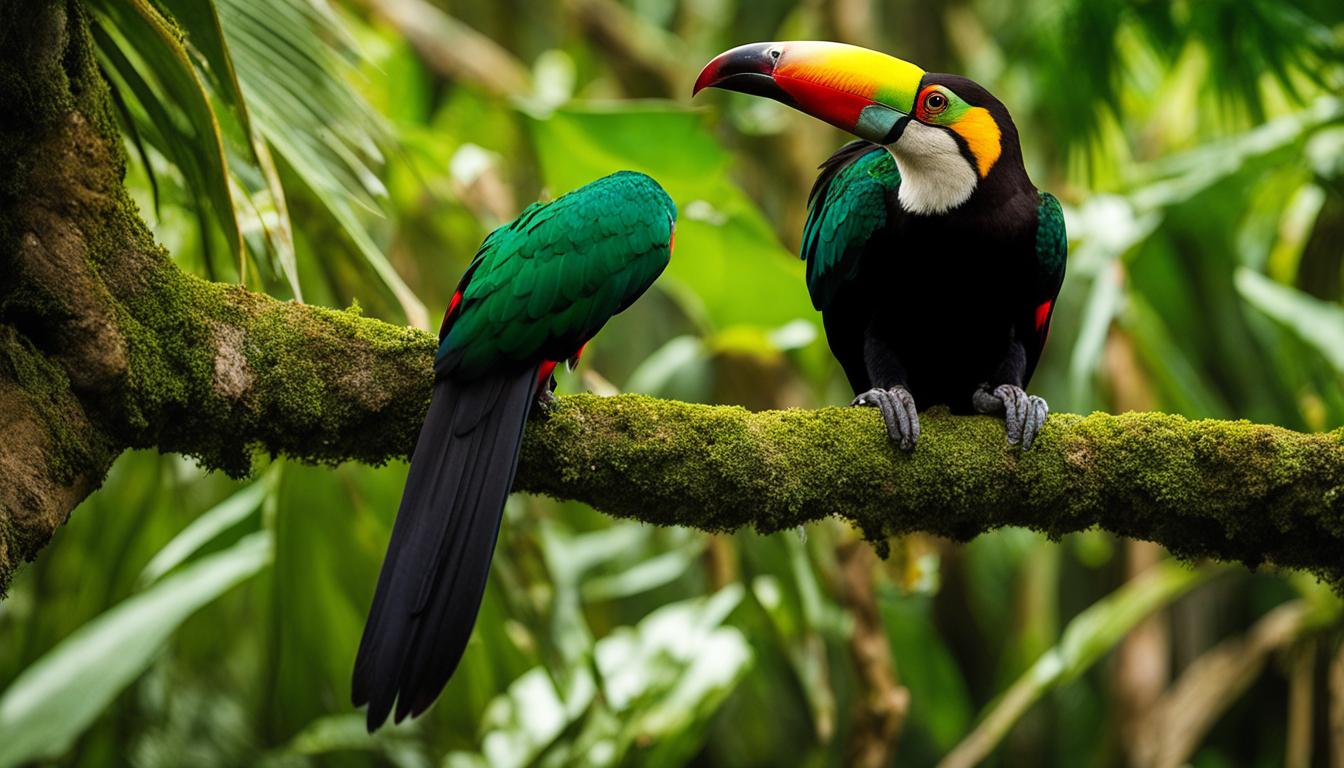Did you know that South America is home to a wide range of diverse and unique animal species? From the colorful rainforests to the impressive mountains, this continent features a remarkable variety of habitats that are home to a diverse range of wildlife. Prepare to discover the captivating world of South American animals and their habitats!
Key Takeaways:
- South America is known for its high biodiversity and diverse ecosystems.
- The continent is home to unique animals like the pink river dolphin, anaconda, giant anteater, and blue morpho butterfly.
- Important habitats in South America include the Amazon Rainforest, Pantanal wetland, Andes mountains, and Galápagos Islands.
- Understanding and conserving South American wildlife is crucial for maintaining the region’s biodiversity.
- Stay tuned to learn more about the incredible animals and habitats of South America!
South American Animal Habitats
South America is home to various important habitats for its wildlife. These habitats support a diverse range of species, contributing to the region’s rich biodiversity. Let’s explore some of the significant habitats found in South America:
1. Amazon Rainforest
The Amazon Rainforest is the largest rainforest in the world, covering a vast area across multiple South American countries. It is known for its unparalleled biodiversity, with countless plant and animal species calling it home. The dense canopy and abundant rivers create a unique ecosystem that supports a wide variety of wildlife.
2. Atlantic Rainforest
The Atlantic Rainforest, also known as the Mata Atlântica, is a lush tropical forest that stretches along the Atlantic coast of Brazil. Despite being highly fragmented due to urbanization and deforestation, it still harbors numerous endemic species, making it one of the most biodiverse habitats on the planet.
3. Cloud Forests of Northwestern South America
The cloud forests of northwestern South America are characterized by their misty atmosphere and high elevation. These unique habitats are found in countries such as Colombia, Ecuador, and Peru. The cool and humid conditions support a range of specialized plant and animal species, including rare orchids and elusive cloud forest birds.
4. Pantanal Wetland
The Pantanal is the world’s largest tropical wetland, spanning parts of Brazil, Bolivia, and Paraguay. This vast floodplain transforms with the seasonal rains, becoming a haven for wildlife. The Pantanal is home to jaguars, giant river otters, caimans, and a plethora of bird species.
5. Cerrado Savanna
The Cerrado is a vast tropical savanna ecoregion, covering a significant portion of central Brazil. It is known for its unique combination of grasslands, scrublands, and forests. The Cerrado is a hotspot for biodiversity, with many endemic species adapted to the savanna’s unique fire-adapted ecosystem.
6. Pampas Grasslands
The Pampas is a vast grassland region that extends across Argentina, Uruguay, and southern Brazil. These fertile plains are home to iconic South American species such as the giant anteater, maned wolf, and rhea. The Pampas also support extensive cattle ranching, contributing to the region’s agricultural economy.
7. Andes Mountain Range
The Andes, the longest continental mountain range in the world, runs along the western edge of South America. This majestic mountain range spans multiple countries and creates diverse habitats, from high-altitude páramo ecosystems to cloud forests and valleys. The Andes are home to unique species like the spectacled bear and the Andean condor.
8. Atacama Desert
The Atacama Desert, located in Northern Chile, is one of the driest places on Earth. Despite its arid conditions, this desert is home to a surprising array of unique flora and fauna, adapted to the harsh environment. From the elusive vicuña to the Andean flamingo, the Atacama Desert offers a glimpse into the resilience of life in extreme habitats.
9. Galápagos Islands
The Galápagos Islands, located off the coast of Ecuador, are renowned for their remarkable wildlife and their role in shaping Charles Darwin’s theory of evolution. These volcanic islands are a true living laboratory, home to species found nowhere else in the world. Giant tortoises, marine iguanas, and Darwin’s finches are just a few examples of the unique wildlife that inhabit this archipelago.
These habitats showcase the incredible and diverse ecosystems that South America has to offer. They are not only important for the survival of numerous species but also hold valuable ecological, cultural, and economic significance. Protecting and conserving these habitats is crucial for maintaining the region’s unique biodiversity and ensuring the well-being of both wildlife and local communities.
| Habitat | Location | Key Species |
|---|---|---|
| Amazon Rainforest | Multiple South American countries | Jaguars, toucans, macaws |
| Atlantic Rainforest | Brazil | Marmosets, sloths, jaguars |
| Cloud Forests of Northwestern South America | Colombia, Ecuador, Peru | Spectacled bears, quetzals, orchids |
| Pantanal Wetland | Brazil, Bolivia, Paraguay | Jaguars, giant river otters, capybaras |
| Cerrado Savanna | Brazil | Maned wolves, jaguars, hyacinth macaws |
| Pampas Grasslands | Argentina, Uruguay, southern Brazil | Giant anteaters, rheas, marsh deer |
| Andes Mountain Range | Multiple South American countries | Spectacled bears, condors, llamas |
| Atacama Desert | Chile | Vicuñas, flamingos, cacti |
| Galápagos Islands | Ecuador | Giant tortoises, marine iguanas, blue-footed boobies |
Amazon River Dolphin (Boto)
The Amazon river dolphin, also known as the Boto or pink river dolphin, is the largest river dolphin species found in South America. With its unique pink coloration, it is a fascinating mammal that inhabits the Amazon River and its tributaries. The Amazon river dolphin is closely related to other river dolphins in South America, such as the Bolivian, Orinoco, and Araguaian river dolphins. However, it is currently classified as an endangered species due to habitat loss and other threats.
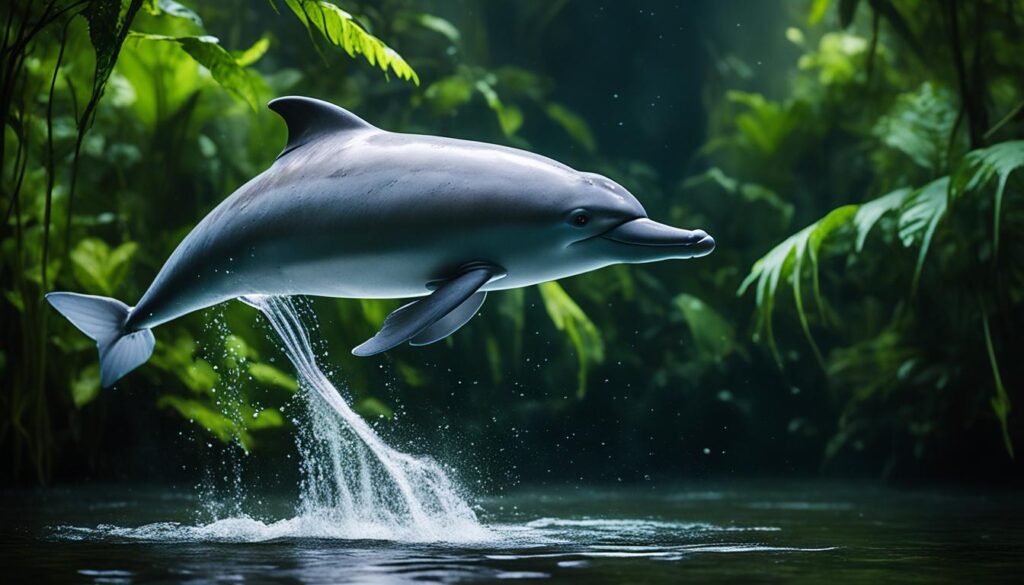
Physical Characteristics and Behavior
The Amazon river dolphin has a distinctive body shape, with a long, slender snout and a muscular body. It typically grows to a length of 6 to 8 feet and can weigh up to 400 pounds. The pink coloration of its skin is caused by blood vessels located close to the surface, which become more pronounced when the dolphin is excited or agitated.
Unlike marine dolphins, the Amazon river dolphin has a flexible neck and can move its head independently, allowing it to navigate the complex river environment. It is known for its playful behavior, often leaping out of the water and performing acrobatic flips.
Habitat and Diet
The Amazon river dolphin is primarily found in the freshwater habitats of the Amazon River basin, including the main river and its tributaries. It prefers slow-moving waters, flooded forests, and oxbow lakes. The dolphin’s diet consists primarily of fish, but it may also consume crustaceans and small mammals.
Conservation Status
The Amazon river dolphin is currently listed as an endangered species by the International Union for Conservation of Nature (IUCN). The main threat to its survival is habitat loss due to deforestation, pollution, and dam construction. The dolphin’s population has also been impacted by illegal fishing practices and accidental entanglement in fishing nets.
Efforts are being made to conserve the Amazon river dolphin and its habitat. These include the establishment of protected areas, the implementation of sustainable fishing practices, and raising awareness about the importance of the species to the ecosystem.
Key Facts about the Amazon River Dolphin
- Scientific name: Inia geoffrensis
- Size: 6 to 8 feet in length
- Weight: Up to 400 pounds
- Habitat: Freshwater habitats of the Amazon River basin
- Conservation status: Endangered
| Threats | Conservation Efforts |
|---|---|
|
|
Anaconda
The anaconda, a group of large, non-venomous constrictor snakes, is a prominent reptile found in the diverse landscapes of South America. With four species in existence, the green anaconda reigns as the largest snake in the world by weight.
Anacondas predominantly dwell in aquatic habitats, making rivers, swamps, and marshes their hunting grounds. These impressive reptiles are known for their remarkable ability to constrict and swallow prey whole, which includes a wide range of animals such as fish, birds, and even caimans. Their powerful muscles allow them to tightly coil around their victims, effectively suffocating them before consumption.
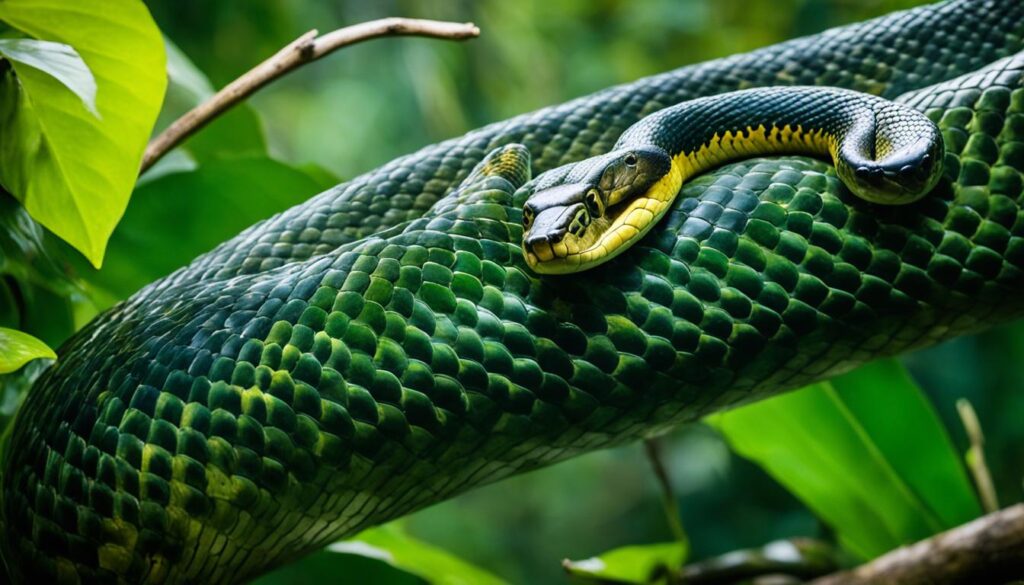
As apex predators, anacondas play a vital role in maintaining the balance of their ecosystems. By helping to control the populations of various prey species, they contribute to the overall health and stability of their habitats.
The Green Anaconda – The Giant of the Amazon
The green anaconda, scientifically known as Eunectes murinus, is the largest and most well-known species of anaconda. It can reach a length of up to 30 feet and weigh more than 550 pounds. The green anaconda’s exceptional size and strength have earned it the title of the heaviest snake in the world.
These incredible reptiles are primarily found in the tropical rainforests and swamps of the Amazon basin, where they have adapted to thrive in both water and land environments. Equipped with efficient respiratory systems, green anacondas can stay submerged for long periods while they patiently wait for their prey.
The green anaconda’s diet consists mainly of aquatic animals such as fish, turtles, and caimans. However, they are opportunistic feeders and will occasionally ambush and consume larger prey, including capybaras, deer, and even jaguars.
“The anaconda, with its astonishing size and incredible strength, exemplifies the natural wonders of South America’s reptilian kingdom.”
Anacondas in Myth and Legend
Throughout history, anacondas have captured the fascination and intrigue of indigenous cultures in South America. These massive snakes have often been the subject of myths, legends, and folklore, representing power and mysticism.
Various indigenous tribes believe that anacondas possess spiritual and healing powers. Their skin and body parts are sometimes used in traditional medicine and rituals. Anacondas are also featured prominently in the art and storytelling of these cultures, symbolizing both fear and respect for the natural world.
The Importance of Anaconda Conservation
Due to habitat destruction and illegal hunting, several species of anaconda, including the green anaconda, are facing threats in the wild. As apex predators, their decline could have significant ecological consequences.
Conservation efforts are crucial to protect and preserve the habitats of anacondas, ensuring their continued existence for future generations to admire and appreciate. By raising awareness and supporting initiatives that promote sustainable practices, we can help safeguard these remarkable reptiles and the biodiversity of South America.
Anteater
Anteaters are fascinating mammals found in South America. There are four species of anteaters, including the giant anteater, silky anteater, northern tamandua, and southern tamandua. These unique animals have long snouts and tongues specialized for eating ants and termites.
Anteaters play a crucial role in controlling insect populations and are well-adapted to their environment.
Anteaters are both land-dwelling and tree-dwelling, with some species having prehensile tails for climbing. They are highly skilled at finding ant and termite nests, using their sharp front claws to break into the nests and their long tongues, which can extend up to two feet, to extract their prey.
These incredible mammals have a keen sense of smell that helps them locate food, as well as strong forelimbs and powerful claws for digging. They are masters of camouflage, blending in with their surroundings to avoid detection by predators.
“Anteaters have fascinating adaptations that allow them to thrive in their environment and efficiently feed on ants and termites. Their elongated snouts and incredibly long tongues are incredible tools for extracting their favorite prey. It’s impressive to see how well they’ve adapted to their specialized diet!” – Dr. Maria Rodriguez, Wildlife Biologist
Anteaters are known for their solitary nature, preferring to live alone and only coming together during the breeding season. The female anteater gives birth to a single offspring, which she carries on her back until it is old enough to venture out on its own. Anteaters have a lifespan of around 15 to 20 years in the wild.
Anteater Species:
- Giant Anteater (Myrmecophaga tridactyla)
- Silky Anteater (Cyclopes didactylus)
- Northern Tamandua (Tamandua mexicana)
- Southern Tamandua (Tamandua tetradactyla)
Let’s take a closer look at the different anteater species:
| Species | Scientific Name | Habitat |
|---|---|---|
| Giant Anteater | Myrmecophaga tridactyla | Grasslands, forests, and savannas |
| Silky Anteater | Cyclopes didactylus | Canopy of tropical rainforests |
| Northern Tamandua | Tamandua mexicana | Forests and woodlands |
| Southern Tamandua | Tamandua tetradactyla | Forests, grasslands, and wetlands |

Argentine Horned Frog
The Argentine horned frog, also known as the ornate pacman frog, is a striking amphibian found in South America. With its brightly-colored skin and horn-like projections above its eyes, it is a unique and visually stunning creature. These frogs have a voracious appetite and will eat almost anything they can fit into their large mouths, including mammals and other frogs. The Argentine horned frog is a nocturnal species and spends most of its time on the forest floor.
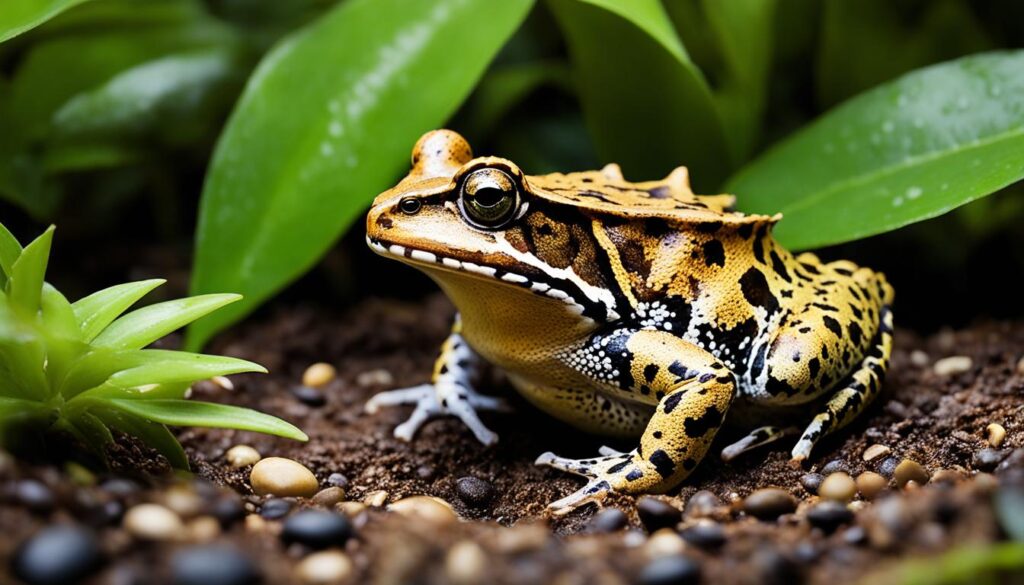
Characteristics of the Argentine Horned Frog
| Feature | Description |
|---|---|
| Body Coloration | Brightly-colored skin with unique patterns |
| Horn-like Projections | Protrusions above the eyes resembling horns |
| Size | Adults can reach up to 4-6 inches in length |
| Diet | Voracious eaters, consuming mammals and other frogs |
| Habitat | Forest floor, often near water sources |
| Nocturnal Behavior | Mainly active at night |
The Argentine horned frog is well-adapted to its environment, using its vibrant coloration as camouflage and its large mouth for capturing prey. Its unique appearance makes it a popular choice among amphibian enthusiasts. These fascinating creatures are an important part of the South American ecosystem, contributing to the balance of their habitat.
Blue Footed Booby
The blue-footed booby is a distinctive seabird found off the coasts of South America and southern North America. With its bright blue feet, it is easily recognizable and known for its unique courtship dance. The male bird lifts and displays each foot in turn to attract females during mating. The blue-footed booby is one of several booby species found in the region and is part of the Sulidae family. They primarily feed on fish and play an important role in marine ecosystems.

| Species | Habitat | Diet |
|---|---|---|
| Blue-footed booby | Coasts of South America and southern North America | Fish |
| Red-footed booby | Tropical islands and coastal regions | Fish, squid, and other marine life |
| Nazca booby | Galápagos Islands and Peru | Fish and squid |
The blue-footed booby, with its striking appearance and unique behaviors, is an important species in the coastal ecosystems of South America. Its blue feet and courtship dance make it a remarkable sight for wildlife enthusiasts and researchers alike.
Blue Morpho Butterfly
The blue morpho butterfly is a large and vibrant butterfly species found in South America. Known for its stunning blue wings, it is a popular sight in tropical rainforests. The blue morpho belongs to the Nymphalidae family and is one of several butterfly species found in the region. These butterflies play an important role in pollination and are a testament to the region’s incredible biodiversity.
If you visit the lush rainforests of South America, you’ll be greeted by the mesmerizing sight of the blue morpho butterfly. With a wingspan of up to 8 inches, the blue morpho flaunts a vibrant blue color that glistens in the sunlight. This striking hue is not caused by pigments, but rather by the microscopic scales on its wings that reflect and refract light, creating an iridescent effect.
As an insect, the blue morpho butterfly goes through a complete metamorphosis, starting as an egg and then transforming into a caterpillar, pupa, and finally emerging as a beautiful butterfly. During its caterpillar stage, the blue morpho feeds on the leaves of host plants, contributing to a balanced ecosystem.
The blue morpho butterfly’s vibrant appearance serves a purpose beyond visual appeal. The bold blue coloration acts as a mechanism of defense against predators. When its wings are closed, the blue morpho butterfly camouflages itself, revealing its brown underside that blends with the surrounding environment. However, when it spreads its wings, the stunning blue color flashes, momentarily startling and confusing potential threats.
The blue morpho butterfly’s importance extends beyond its aesthetic qualities. As pollinators, these butterflies facilitate the reproduction of plants by transferring pollen from the male to the female reproductive organs. This crucial role in the ecosystem ensures the survival and diversity of plant species in the rainforest.

Overall, the blue morpho butterfly is a captivating symbol of South America’s rich biodiversity. Its vibrant blue wings, unique life cycle, and essential contribution to pollination make it a remarkable insect that highlights the delicate balance of nature in the region.
Boa Constrictor
The boa constrictor is a formidable reptile that can be found in various habitats across South and Central America. This large constrictor snake is renowned for its impressive size, strength, and unique hunting strategy. Unlike venomous snakes, the boa constrictor does not rely on venom to subdue its prey. Instead, it uses its powerful muscles to constrict and suffocate its victims, often squeezing them to the point of immobilization.
Boa constrictors are highly adaptable and can thrive in diverse environments, including forests, swamps, and grasslands. This versatility has allowed them to establish a widespread presence throughout their native range. As part of the Boidae family, which also includes other boa species, these reptiles have evolved to become efficient predators.
One of the most fascinating aspects of boa constrictors is their incredible size. While individual snakes can vary in length, some specimens have been known to reach impressive dimensions. The largest recorded boa constrictor measured over 18 feet in length. Such formidable size allows these creatures to overpower and consume prey that are much larger than themselves.
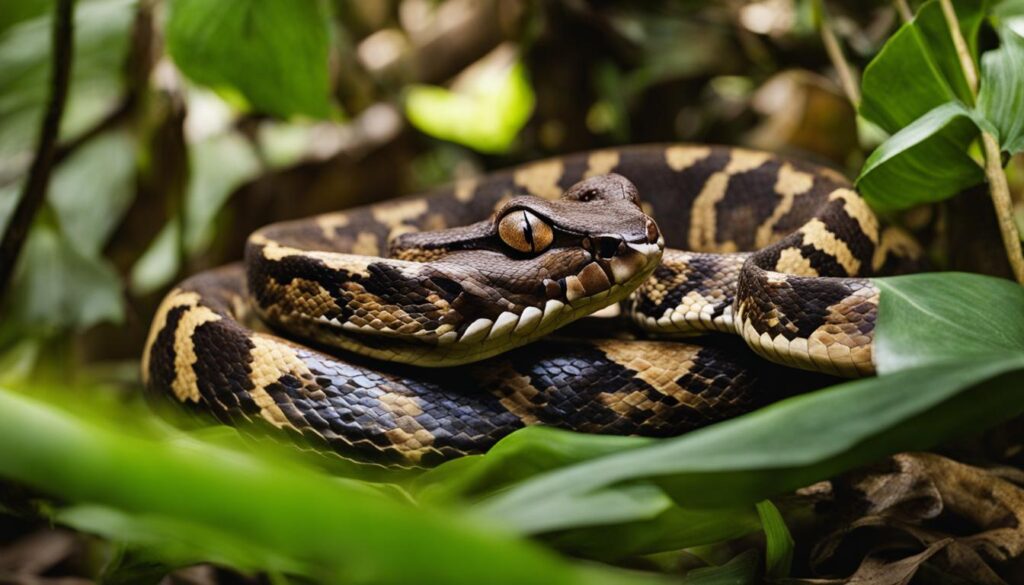
Boa constrictors have a diverse diet that includes small mammals, birds, and other reptiles. They are opportunistic hunters and can patiently wait for their prey to pass by before striking. Once captured, the boa constrictor wraps its muscular body around the prey, exerting increasing pressure with each breath the prey takes until it can no longer breathe.
Unfortunately, due to habitat loss and illegal pet trade, boa constrictors are facing various conservation challenges. However, efforts are being made to protect these reptiles and ensure their survival in the wild. Education and awareness programs are crucial in promoting the importance of maintaining the balance of the ecosystem in which these incredible creatures play a significant role.
Caiman
Caimans are fascinating reptiles that can be found in various freshwater habitats throughout South America. Belonging to the Alligatoridae family, they are closely related to alligators and share many similarities with them. With six different species, caimans come in a range of sizes, from the petite Cuvier’s dwarf caiman to the impressive black caiman, which holds the title of being the largest member of the alligator family.
These reptiles play a vital role in their ecosystems as top predators. They help maintain the balance of their respective environments by regulating the population of their prey and other species within the food chain. Caimans contribute to the overall health and stability of the freshwater habitats they inhabit, making them an essential part of the South American reptile kingdom.
While caimans may resemble alligators in appearance, there are some distinct differences between the two. One notable characteristic is their snout shape. Caimans have a broader, shorter snout compared to alligators, which have narrower, longer snouts. Additionally, caimans tend to be more aggressive and territorial, especially during the breeding season.
These incredible reptiles are often found in rivers, wetlands, and other bodies of water in South America. Their adaptation to freshwater habitats allows them to thrive in these environments, making them well-suited to their surroundings. Caimans are capable swimmers and can navigate through water with ease, utilizing their muscular bodies and powerful tails.

The Role of Caimans in their Ecosystems
The presence of caimans in South American freshwater habitats is crucial for maintaining a balanced ecosystem. As top predators, they help control the population of their prey species, such as fish and smaller reptiles. By regulating these populations, caimans prevent an overabundance of certain species and ensure the overall health and stability of the ecosystem.
Caimans play an important role in South American ecosystems as top predators, regulating the population of their prey and maintaining the balance of their environments. Their presence contributes to the overall health and stability of freshwater habitats in the region.
The Importance of Caiman Conservation
Conservation efforts for caimans are essential to safeguard their populations and the ecosystems they inhabit. Habitat destruction, pollution, and illegal hunting are significant threats to their survival. By raising awareness about the importance of caimans and implementing protective measures, we can ensure the long-term survival of these incredible reptiles and the preservation of their habitats.
Conclusion
South America is a treasure trove of unique and diverse animal species. From pink river dolphins and anacondas to giant anteaters and jaguars, the continent offers a rich array of wildlife that is both fascinating and crucial for the ecosystem.
The different habitats found in South America, including rainforests, wetlands, grasslands, and mountains, provide the perfect conditions for these animals to thrive. The Amazon Rainforest, with its immense biodiversity, and the Pantanal wetland, known as the world’s largest tropical wetland, are just a few examples of the exceptional habitats found in the region.
By understanding and appreciating the incredible biodiversity of South America, we can work towards their conservation and ensure their survival for generations to come. Preserving these unique animals and their habitats is not only essential for their well-being, but also for the overall health of our planet. Let us continue to marvel at the wonders of South America’s wildlife and take action to protect them.
